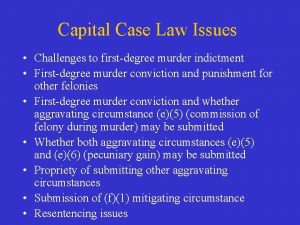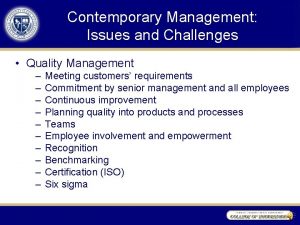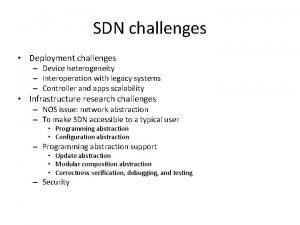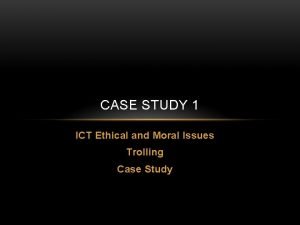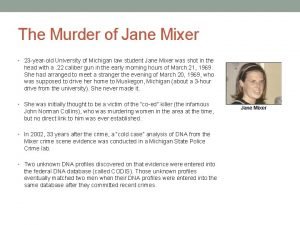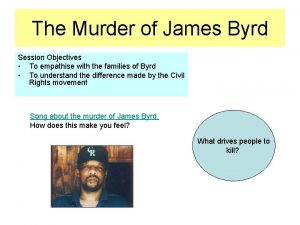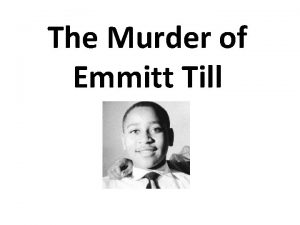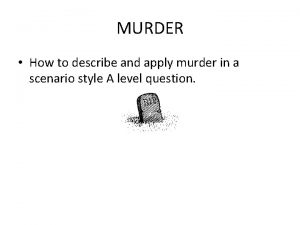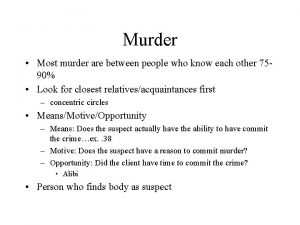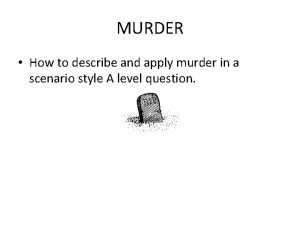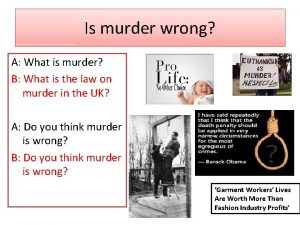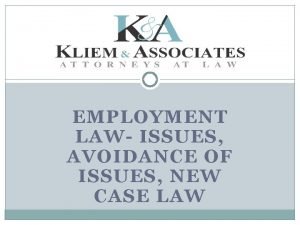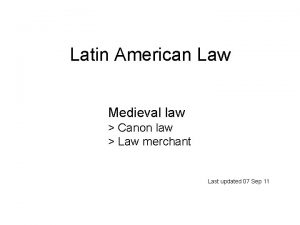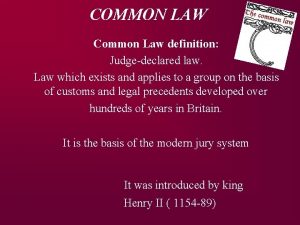Capital Case Law Issues Challenges to firstdegree murder




























- Slides: 28

Capital Case Law Issues • Challenges to first-degree murder indictment • First-degree murder conviction and punishment for other felonies • First-degree murder conviction and whether aggravating circumstance (e)(5) (commission of felony during murder) may be submitted • Whether both aggravating circumstances (e)(5) and (e)(6) (pecuniary gain) may be submitted • Propriety of submitting other aggravating circumstances • Submission of (f)(1) mitigating circumstance • Resentencing issues

First-Degree Murder Indictment • Short-form indictment is constitutional – State v. Wallace, 351 N. C. 481 (2000) – See also Hartman v. Lee, 283 F. 3 d 190 (4 th Cir. 2002) (federal habeas standard of review) • Indictment need not allege aggravating circumstances – State v. Golphin, 352 N. C. 364 (2000) – Same state court ruling likely after Ring v. Arizona, 122 S. Ct. 2428 (2002) (jury must find aggravating circumstance necessary to impose death sentence)

First-Degree Murder Indictment • When state proceeds under felony murder rule, it is not required to separately indict for underlying felony or felonies – State v. Carey, 288 N. C. 254, 274 (1975); State v. Williams, 305 N. C. 656, 660 (1982); State v. Scott, ___ N. C. App. ___ (4 June 2002) • Attempted first-degree murder is lesser-included offense, but not felonious assaults – State v. Collins, 334 N. C. 54 (1993); State v. Gibson, 333 N. C. 29 (1992)

First-Degree Murder Conviction and Punishment for Other Felony Conviction(s) • First-degree murder conviction based only on felony murder theory – Must arrest judgment on underlying felony conviction supporting felony murder theory – If two or more felonies submitted to jury, must arrest judgment for only one of the felony convictions – Judgment is not arrested for conviction(s) of other felony or felonies not submitted to jury under felony murder theory

First-Degree Murder Conviction Based on P&D and Felony Murder • Sentencing allowed for felony conviction(s) that supported felony murder theory

First-Degree Murder Conviction When Jury Fails to Indicate Theories • Case is treated as though jury relied on felony murder theory • Of course, judge should instruct jury to specify theory or theories in their verdict

Plea of Guilty/No Contest to First -Degree Murder • Defendant is convicted of all theories on which there is supporting evidence • May state plea bargain with defendant to limit theories? – State v. Green, 336 N. C. 142 (1994); State v. Howell, 335 N. C. 457 (1994)

Aggravating Circumstance (e)(5) • Aggravating circumstance (e)(5): murder committed during specified felony or felonies • Each felony is separate aggravating circumstance • Timing of felony – Felony may be committed after murder if felony occurs during continuous series of events surrounding murder

Effect of First-Degree Murder Verdict on Submitting Aggravating Circumstance (e)(5) If first-degree murder verdict is based on both P&D and felony murder theory – (e)(5) may be submitted based on felony or felonies submitted to support felony murder theory – (e)(5) may be submitted based on felony or felonies not submitted to support felony murder theory

Effect of First-Degree Murder Verdict on Submitting Aggravating Circumstance (e)(5) • If first-degree murder verdict is based on felony murder theory only – (e)(5) may not be submitted based on felony supporting felony murder theory – (e)(5) may be submitted for felony that judge did not submit to jury to support felony murder theory • State v. Richardson, 342 N. C. 772 (1996) [only rape was submitted as felony for felony murder; proper to submit armed robbery as (e)(5)]

Multiple Aggravating Circumstances • Generally, same evidence may not be used to support multiple aggravating circumstances – No bar if overlapping evidence supports multiple aggravating circumstances – No bar if aggravating circumstances are directed at different aspects of defendant’s character or murder • Judge should instruct jury about not using same evidence to find more than one aggravating circumstance – State v. Gay, 334 N. C. 467 (1993) – N. C. P. I—Crim. 150. 10 [located after instruction on (e)(11)]

Submission of Aggravating Circumstances (e)(5) and (e)(6) • (e)(6): murder committed for pecuniary gain • If first-degree murder conviction is based on felony murder theory only – And felony was robbery, for example – Judge may not submit (e)(5) – Judge may submit (e)(6) • State v. Quesinberry, 319 N. C. 228 (1987)

Submission of Aggravating Circumstances (e)(5) and (e)(6) • If first-degree murder conviction based on P&D and felony murder – And felony was robbery or burglary, for example – Judge may submit either (e)(5) or (e)(6) • But not both if motive for (e)(5) was pecuniary gain • State v. Quesinberry, 319 N. C. 228 (1987) (robbery); State v. Howell, 335 N. C. 457 (1994) (burglary)

Submission of Both Aggravating Circumstances (e)(5) and (e)(6) • When both (e)(5) and (e)(6) may be submitted – Jury instruction should make clear what evidence is admissible for each aggravating circumstance • Defendant took victim’s money and car keys to drive car away – (e)(5) robbery of car keys and car – (e)(6) pecuniary gain in taking money • State v. East, 345 N. C. 535 (1997) • State v. Davis, 353 N. C. 1 (2000) • State v. White, 355 N. C. 696 (2002)

Submission of Aggravating Circumstances (e)(4) and (e)(8) Involving Law Enforcement Officer • (e)(4) (murder committed to avoid or prevent lawful arrest or to effect escape from custody) • (e)(8) (murder committed against officer while engaged in performing official duty) • General rule: same evidence cannot support multiple aggravating circumstances – But not when circumstances are directed at • Different aspects of defendant’s character or murder for which defendant is to be punished

Submission of Aggravating Circumstances (e)(4) and (e)(8) Involving Law Enforcement Officer • Both may be submitted because – (e)(4) addresses defendant’s motive for murder – (e)(8) addresses factual basis of murder • Cases involving officers: – State v. Nicholson, 355 N. C. 1 (2002) – State v. Golphin, 352 N. C. 364 (2000) – State v. Hutchins, 303 N. C. 321 (1981)

Submission of Aggravating Circumstances (e)(7) and (e)(8) Not Involving Officer • (e)(7): murder committed to disrupt or hinder lawful exercise of government function or enforcement of laws • (e)(8): murder of witness against defendant while witness engaged in performing official duty or because of exercise of official duty

State v. Anthony, 354 N. C. 372 (2001) • DVPO issued for wife against defendant-husband • Wife scheduled to return to court, but is murdered by defendant before court date • Rulings: – Sufficient evidence for both (e)(7) and (e)(8) – But error to submit both because they were based on same evidence • Court distinguished State v. Gray, 347 N. C. 143 (1997)

State v. Gray, 347 N. C. 143 (1997) • (e)(7): show cause order for contempt involving accounting of marital monies in divorce action returnable a few days after murder • (e)(8): wife was to be witness in four criminal warrants against defendant • Ruling: not error to submit both (e)(7) and (e)(8) because evidence was not identical to prove both

Two prongs of (e)(8): State v. Long, 354 N. C. 534 (2001) Victim killed five days before defendant’s trial for assault against her Two prongs of (e)(8) 1. Murdered while “engaged in” performance of official duties 2. Murdered “because” of exercise of official duty

Two prongs of (e)(8): State v. Long, 354 N. C. 534 (2001) • Fact that witness waiting to testify may be considered under both prongs • “Because” prong – State must show defendant’s motivation to murder victim was because she was a witness – May be submitted although victim had not yet testified • “Engaged in” prong – State must show victim was actively engaged at time of murder with performing duty of witness • Swearing out warrant • Discussing case with prosecutor • Going to court to testify • Actively testifying

Two prongs of (e)(8): State v. Long, 354 N. C. 534 (2001) • Witness is not always “engaged in” official duties during entire time period when witness swears out warrant until completion of testimony • Court disavowed language in State v. Gray that implied otherwise

Mitigating circumstance (f)(1) (no significant prior criminal history) • Consider only criminal acts committed before murder for which defendant is being sentenced – State v. Coffey, 336 N. C. 412 (1994); State v. Gell, 351 N. C. 192 (2000) • If evidence is sufficient, must be submitted even if defendant does not request submission or objects to its submission – State v. Quick, 337 N. C. 359 (1994)

Mitigating circumstance (f)(1) (no significant prior criminal history) • If judge submits circumstance over defendant’s objection – Judge should instruct jury that • defendant did not request submission, and • submission is required as matter of law because of evidence in case – Prosecutor may not argue that defendant has requested submission or sought to have jury find it • Absent extraordinary facts, erroneous submission of mitigating circumstance is harmless – State v. Walker, 343 N. C. 216 (1996); State v. Smith, 347 N. C. 453 (1998); State v. Bone, 354 N. C. 1 (2001)

Mitigating circumstance (f)(1) (no significant prior criminal history) • Factors in deciding sufficiency of evidence to submit circumstance – Were criminal acts recent or not recent? – Were criminal acts violent or nonviolent?

Resentencing Issues • State is not bound by its stipulation at prior hearing that aggravating circumstance did not exist or that mitigating circumstance did exist – State v. Adams, 347 N. C. 48 (1997); State v. Flippen, 349 N. C. 264 (1998) • Aggravating circumstance may be submitted even if not submitted or found at prior hearing – State v. Sanderson, 346 N. C. 669 (1997) • No collateral estoppel to require finding of mitigating circumstance at new hearing that had been found at prior hearing – State v. Adams, 347 N. C. 48 (1997)

Miscellaneous Issues • Accomplice’s sentence is not mitigating circumstance – State v. Jaynes, 353 N. C. 534 (2001); State v. Meyer, 353 N. C. 92 (2000) • Directed verdict is not appropriate for statutory mitigating circumstance – Use peremptory instruction when uncontradicted evidence exists – State v. Holden, 346 N. C. 404 (1997) • Mandatory peremptory instruction is required when state stipulates to existence of statutory mitigating circumstance – State v. Flippen, 344 N. C. 689 (1996)

Miscellaneous Issues • Timing of prior violent felony conviction under aggravating circumstance (e)(3) – Commission of violent felony must occur before commission of first-degree murder – But conviction of violent felony may occur after commission of first-degree murder – State v. Lyons, 343 N. C. 1 (1996)
 Firstdegree murder
Firstdegree murder A case of murder vernon
A case of murder vernon Facts about vernon scannell
Facts about vernon scannell Best worst and average case
Best worst and average case What are contemporary management issues
What are contemporary management issues Big data: issues, challenges, tools and good practices
Big data: issues, challenges, tools and good practices Sdn issues and challenges
Sdn issues and challenges Efficient capital markets and behavioral challenges
Efficient capital markets and behavioral challenges Newton's first law and second law and third law
Newton's first law and second law and third law Newton's first law and second law and third law
Newton's first law and second law and third law Boyle's law charles law avogadro's law
Boyle's law charles law avogadro's law How to calculate boyle's law
How to calculate boyle's law Gross operating cycle
Gross operating cycle Source of capital reserve
Source of capital reserve Multinational capital structure
Multinational capital structure Difference between capital reserve and reserve capital
Difference between capital reserve and reserve capital Regulatory capital vs economic capital
Regulatory capital vs economic capital Regulatory capital vs economic capital
Regulatory capital vs economic capital Variable capital examples
Variable capital examples Multinational cost of capital and capital structure
Multinational cost of capital and capital structure Capital allocation line vs capital market line
Capital allocation line vs capital market line Ethical issues in information systems
Ethical issues in information systems Facebook ethical issues case study
Facebook ethical issues case study Work immersion grading system
Work immersion grading system The raven text
The raven text Gary leiterman young
Gary leiterman young Donald byrd murder
Donald byrd murder The murder of emmitt till date
The murder of emmitt till date Steven benson death
Steven benson death
